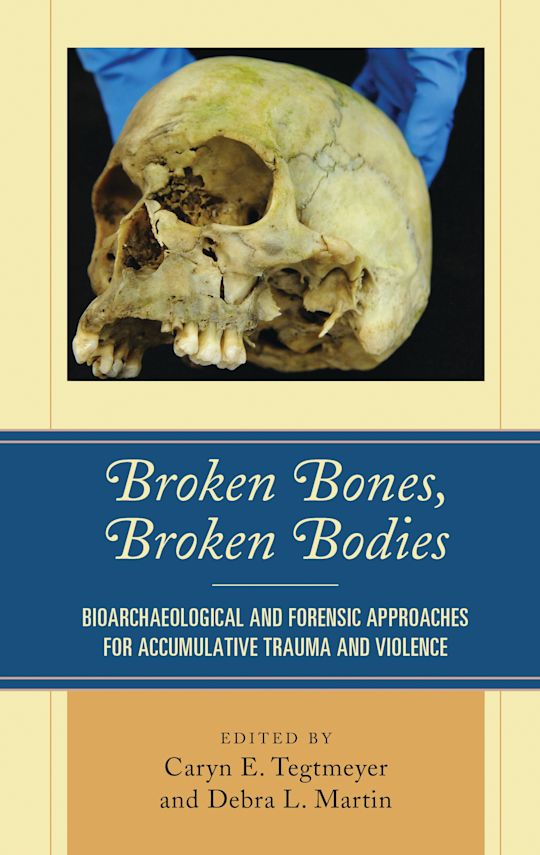- Home
- ACADEMIC
- Archaeology
- Archaeology - Other
- Broken Bones, Broken Bodies
Broken Bones, Broken Bodies
Bioarchaeological and Forensic Approaches for Accumulative Trauma and Violence
Caryn E. Tegtmeyer (Anthology Editor) , Debra L. Martin (Anthology Editor) , Petra Banks (Contributor) , Eric J. Bartelink (Contributor) , Derek A. Boyd (Contributor) , John J. Crandall (Contributor) , Michelle Davenport (Contributor) , Carlina de la Cova (Contributor) , Sharon M. Derrick (Contributor) , William O. Gazza (Contributor) , Ryan P. Harrod (Contributor) , Margaret Judd (Contributor) , Meaghan A. Kincaid (Contributor) , Ryan King (Contributor) , Kristin A. Kuckelman (Contributor) , Jennifer C. Love (Contributor) , Sarah A. Mathena (Contributor) , Heather L. MacInnes (Contributor) , Debra L. Martin (Contributor) , Colleen F. Milligan (Contributor) , Julia R. Prince-Buitenhuys (Contributor) , Sarah A. Schrader (Contributor) , Stuart Tyson Smith (Contributor) , Caryn E. Tegtmeyer (Contributor) , Alyssa Y. Willett (Contributor) , Aaron R. Woods (Contributor) , Molly K. Zuckerman (Contributor)
Broken Bones, Broken Bodies
Bioarchaeological and Forensic Approaches for Accumulative Trauma and Violence
Caryn E. Tegtmeyer (Anthology Editor) , Debra L. Martin (Anthology Editor) , Petra Banks (Contributor) , Eric J. Bartelink (Contributor) , Derek A. Boyd (Contributor) , John J. Crandall (Contributor) , Michelle Davenport (Contributor) , Carlina de la Cova (Contributor) , Sharon M. Derrick (Contributor) , William O. Gazza (Contributor) , Ryan P. Harrod (Contributor) , Margaret Judd (Contributor) , Meaghan A. Kincaid (Contributor) , Ryan King (Contributor) , Kristin A. Kuckelman (Contributor) , Jennifer C. Love (Contributor) , Sarah A. Mathena (Contributor) , Heather L. MacInnes (Contributor) , Debra L. Martin (Contributor) , Colleen F. Milligan (Contributor) , Julia R. Prince-Buitenhuys (Contributor) , Sarah A. Schrader (Contributor) , Stuart Tyson Smith (Contributor) , Caryn E. Tegtmeyer (Contributor) , Alyssa Y. Willett (Contributor) , Aaron R. Woods (Contributor) , Molly K. Zuckerman (Contributor)
You must sign in to add this item to your wishlist. Please sign in or create an account
Description
Injury recidivism is a continuing health problem in the modern clinical setting and has been part of medical literature for some time. However, it has been largely absent from forensic and bioarchaeological scholarship, despite the fact that practitioners work closely with skeletal remains and, in many cases, skeletal trauma. The contributors to this edited collection seek to close this gap by exploring the role that injury recidivism and accumulative trauma plays in bioarchaeological and forensic contexts. Case examples from prehistoric, historic, and modern settings are included to highlight the avenues through which injury recidivism can be studied and analyzed in skeletal remains and to illustrate the limitations of studying injury recidivism in deceased populations.
Table of Contents
Chapter 1: Injury Recidivism Revisited: Clinical Research, Limitations and Implications for Bioarchaeology, by Margaret Judd
Part I: Prehistoric Case Studies of Injury Recidivism
Chapter 2:Socializing Violence: Interpersonal Violence Recidivism at Abu Fatima (Sudan), by Sarah A. Schrader and Stuart Tyson Smith
Chapter 3: Cranial Trauma and Victimization among Ancestral Pueblo Farmers of the Northern San Juan Region, by Kristin A. Kuckelman
Chapter 4: Injury and Re-injury among the Ancestral Pueblo and Fremont, by Ryan P. Harrod, Alyssa Willett, Meaghan Kincaid, Aaron Woods
Part II: Historic Case Studies of Injury Recidivism
Chapter 5: Disease, Trauma & Stigma: Did Chronic Infection with Syphilis Influence Experiences of Trauma and Recidivistic Trauma in Post-Medieval London? by Molly K. Zuckerman, Michelle Davenport, Petra Banks, and Ryan King
Chapter 6: Evaluating the Evidence for Injury Recidivism in Two Parish Communities from Industrial-era London, by Derek A. Boyd and Colleen F. Milligan
Chapter 7: Sugar and Suffering: A Case Study on Injury Recidivism, Overall Health, and Structural Violence from the Holy Trinity Lutheran Church, by Sarah A. Mathena and Molly K. Zuckerman
Chapter 8: The Bioarchaeology of Violence Recidivism and Labor Abuse in 19th Century Chinese by Ryan P. Harrod and John J. Crandall
Chapter 9: Fractured Lives: Structural Violence, Trauma, and Recidivism in Urban and Industrialized 19th-Century-Born African Americans and Euro-Americans, by Carlina de la Cova
Part III: Contemporary Case Studies of Injury Recidivism
Chapter 10: An Exploration of Skeletal Evidence of Injury Recidivism in Cases of Transients and Homelessness from Northern California, by Julia R. Prince-Buitenhuys, Heather L. MacInnes, Colleen F. Milligan, and Eric J. Bartelink
Chapter 11: Homicide in Sin City: Patterns of Violent Death and Injury Recidivism in Clark County, NV, by Caryn E. Tegtmeyer, Debra L. Martin, and William Gazza
Chapter 12: A Life History of Skeletal Trauma: Cases from a Medical Examiner’s Office, by Jennifer C. Love and Sharon M. Derrick
Conclusion, by Debra L. Martin and Caryn E. Tegtmeyer
About the Contributors
Product details
| Published | 14 Jul 2017 |
|---|---|
| Format | Ebook (PDF) |
| Edition | 1st |
| Extent | 270 |
| ISBN | 9798216235538 |
| Imprint | Lexington Books |
| Illustrations | 14 BW Illustrations, 12 Tables |
| Publisher | Bloomsbury Publishing |
About the contributors
Reviews
-
An engaging collection of papers concerning a health condition that many bioarchaeologists will have encountered but may not have formally identified. The cultural contexts of the studies are quite varied, and this helps to illustrate the different circumstances in which injury recidivism may occur.... I hope this stimulating volume encourages scholarly attention to these areas.
International Journal of Paleopathology
-
This book captures a zeitgeist in the study of human remains, reflecting the coming-together of shared research themes and ethical concerns in the disciplines of forensic anthropology and bioarcheology. These diverse studies show that regardless of time and space, the lives of injury recidivists have shared commonalities: structural violence and socio-economic inequalities. Their osteobiographies are powerful; and at times, make for heart-breaking reading. They serve to remind us that our work has impact and resonance for understanding the wider social context in which injuries are sustained, all too frequently by the most vulnerable in a community.
Rebecca Redfern, Museum of London



































